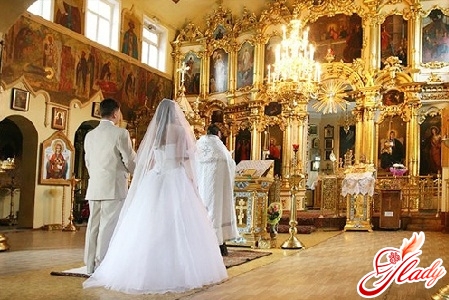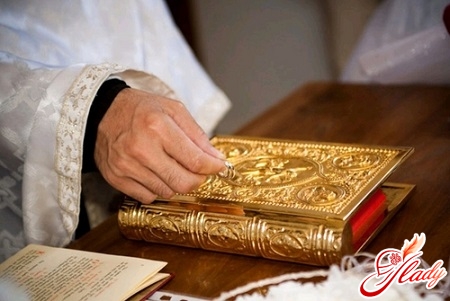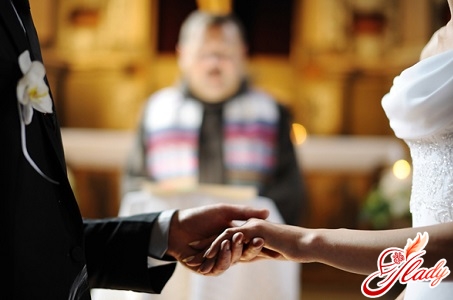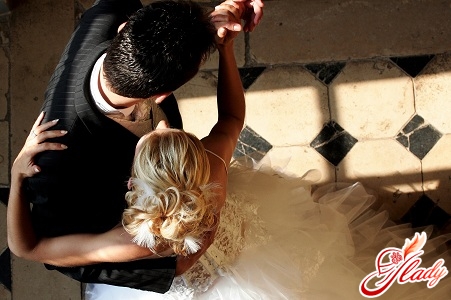 The birth of a new family in all nations and in alltimes are celebrated solemnly and solemnly. In each country, such a significant event has its own traditions and peculiarities. And on the same territory, depending on the state formed at one time or another, completely new customs, rules and procedures may come into being, or return, seemingly forever forgotten. For example, registrars appeared only in the Soviet era, and before in our country they did not put stamps in their passports and the word "sign" had a completely different meaning. Since ancient times, a wedding ceremony has been held in Russia. The celebration was incredibly pompous and imposing in scale. He was preceded by a long preparation, so that everything went smoothly and the guests did not have a reason to whisper behind the backs of the newlyweds' parents. To the church sacrament, both the people of the poor estate and the nobility were equally serious. In Russia, the wedding ceremony was held in the Orthodox Church. In the decorated gilded church, before the icon painting of the Lord Himself, the newlyweds gave a vow to the clergyman to bear the responsibilities and responsibility for each other for the rest of his life. And these oaths sounded quite differently, they made a special sense, because even in those distant ages people treated to marriage with much less levity than now. Indeed, with the ceremony of the wedding in the time of Orthodox Russia, marriages took place in heaven. Then, after the change of power, another tradition appeared in the country to celebrate and formalize the beginning of family life. Faith in God was outlawed, and accordingly the role of the church in the life of youth has lost its former importance. The main symbols of the marriage were Mendelssohn's march, a record in the civil status book and a stamp in the passport. The Orthodox wedding ceremony was actively opposed by the Bolsheviks, and those who secretly dared to face it faced a severe punishment. And what about today? Modern rules still prescribe mandatory registration in the registry office, but now the newlyweds have the opportunity to turn to the age-old traditions of Orthodoxy and get married. Whether to conduct a rite in the church or not, depends only on the desire of the bride and groom. In recent years, the wedding has become particularly popular. The priests themselves explain this by the fact that the number of parishioners among the younger generation has greatly increased. But there is also one more reason, thanks to which newlyweds after the REGISTRY OFFICE rush under the arches of the church, it became fashionable to get married. The beauty of the rite itself, the solemnity of the situation, the opportunity to touch the age-old Orthodox traditions, the blessing of the heavens, the bell ringing, the singing of the church choir are very strong and vivid moments that mark the importance of family life and are remembered forever. But those who are planning to swear before the altar for the first time, are concerned with the question of how the wedding takes place in the Orthodox Church? What precedes the ceremony itself? What traditions have survived to this day?
The birth of a new family in all nations and in alltimes are celebrated solemnly and solemnly. In each country, such a significant event has its own traditions and peculiarities. And on the same territory, depending on the state formed at one time or another, completely new customs, rules and procedures may come into being, or return, seemingly forever forgotten. For example, registrars appeared only in the Soviet era, and before in our country they did not put stamps in their passports and the word "sign" had a completely different meaning. Since ancient times, a wedding ceremony has been held in Russia. The celebration was incredibly pompous and imposing in scale. He was preceded by a long preparation, so that everything went smoothly and the guests did not have a reason to whisper behind the backs of the newlyweds' parents. To the church sacrament, both the people of the poor estate and the nobility were equally serious. In Russia, the wedding ceremony was held in the Orthodox Church. In the decorated gilded church, before the icon painting of the Lord Himself, the newlyweds gave a vow to the clergyman to bear the responsibilities and responsibility for each other for the rest of his life. And these oaths sounded quite differently, they made a special sense, because even in those distant ages people treated to marriage with much less levity than now. Indeed, with the ceremony of the wedding in the time of Orthodox Russia, marriages took place in heaven. Then, after the change of power, another tradition appeared in the country to celebrate and formalize the beginning of family life. Faith in God was outlawed, and accordingly the role of the church in the life of youth has lost its former importance. The main symbols of the marriage were Mendelssohn's march, a record in the civil status book and a stamp in the passport. The Orthodox wedding ceremony was actively opposed by the Bolsheviks, and those who secretly dared to face it faced a severe punishment. And what about today? Modern rules still prescribe mandatory registration in the registry office, but now the newlyweds have the opportunity to turn to the age-old traditions of Orthodoxy and get married. Whether to conduct a rite in the church or not, depends only on the desire of the bride and groom. In recent years, the wedding has become particularly popular. The priests themselves explain this by the fact that the number of parishioners among the younger generation has greatly increased. But there is also one more reason, thanks to which newlyweds after the REGISTRY OFFICE rush under the arches of the church, it became fashionable to get married. The beauty of the rite itself, the solemnity of the situation, the opportunity to touch the age-old Orthodox traditions, the blessing of the heavens, the bell ringing, the singing of the church choir are very strong and vivid moments that mark the importance of family life and are remembered forever. But those who are planning to swear before the altar for the first time, are concerned with the question of how the wedding takes place in the Orthodox Church? What precedes the ceremony itself? What traditions have survived to this day?
Basic rules of the wedding
Orthodox rite of the wedding in the churchprovides its own rules and laws, without which the sacrament of marriage is impossible. Like the baptism of an infant, a new union of two people can not be imagined without centuries of established traditions. The main one is the obligatory requirement of the church: only people who are seriously related to religion and who follow its provisions and beliefs, who are necessarily baptized, can get the opportunity to pass the ceremony of engagement and wedding. Those who are atheists and do not believe, marry under the dome of the Orthodox church is prohibited. The age for the wedding ceremony in the church is this: the bridegroom must be eighteen years old, and the bride - sixteen. A great role for the sacrament of marriage in the temple is played by the fact whether young people belong to the same family tree. Orthodoxy does not recognize alliances between relatives up to the fourth degree of kinship. Such marriages are considered a sin. Here, science is quite in solidarity with the church. To this, the learned men have a simple and understandable explanation: the immune system of descendants from parents-relatives is weakened, the hereditary diseases (for example, "royal" hemophilia disease) are more pronounced, and as a result the genus degenerates. The ceremony of the wedding also presupposes one more important moment, without which the young can not stand before the altar. It is necessary that parents agree with the alleged marriage. The father with the mother and the bride and groom should give them their parental blessing. Otherwise it was believed that the union could not become happy, and the offspring of him would be born sick and weak. Since the times of Ancient Rus young did not risk to get married without the consent of their parents. True, sometimes the bride and groom, in spite of the desire of the father and mother, secretly escaped and married in a small temple, taking as witnesses the first comers. But this was a great rarity, because young people usually obeyed the will of the older generation. Therefore, often there were alliances of a young girl and an elderly man. And as if the bride was not disgusted with the choice of parents, but she could not disobey their will. Education did not allow. It would be for our modern young girls to move for a while in that era. It is interesting, how would they react to some of the restrictions that the current parents are still putting forward? Won, according to the Orthodox religious law, you can be no more than three times. All subsequent marriages the church, unlike loyal registrars, does not recognize. Perhaps this is precisely what explains the strength of the alliances that were once concluded, even in the pre-revolutionary period. However, the ceremony of the wedding in the church is allowed only after registration in this most loyal civil registry office. This is the essence of the unspoken treaty between the state and the church. It should be noted that similar rules exist in most European countries. But in Catholic Germany, for example, a wedding is allowed without first registering a union in a state body. True, such a marriage does not affect the amount of taxes that a man and a woman must pay to become a husband and wife according to church law. It turns out that their family status does not change in the eyes of the state. Therefore, the German newlyweds, like us, are not limited to the union before God. The time of the wedding is also very important. You can not conduct rituals during any of the Great Lent and Fasting Days (Tuesday and Thursday). The church allows to get married before or after. This is due to the fact that the wedding feast, necessarily accompanying the wedding, serves as a violation of the harassment. Do not hold marriage unions on Saturdays, as well as on the eve of the great and temple holidays. In addition, certain days in September are also an exception to the calendar. Therefore, it is necessary to register for the wedding in advance, it is better to do it three weeks before the expected date. It should also be taken into account that the rite is performed in the morning or in the afternoon, after the Liturgy is completed. This should be taken into account when choosing the timing of the registry office, if both ceremonies are scheduled in one day. In addition to the newlyweds, witnesses take part in the ceremony - one from each side. Usually their roles are played by the unmarried close friend of the bride and the groom's friend who is not bound by marriage. To conduct a wedding ceremony, you need to have two icons - Jesus Christ and the Mother of God. Usually in families living according to the laws of Orthodoxy, these images are passed from the older generation to the younger one and therefore are of great value. If you do not have icons, then you can buy them in the church. You also need to have with you wedding rings, according to tradition, one of them should be gold, and the second - silver. Another necessary attribute for the upcoming ceremony are the wedding candles (bought in the temple). You will also need two wedding towels, one of which creeps under the feet of the young, and the second during the wedding their hands are tied. You can not do without four handkerchiefs, in which the newlyweds will need to hold candles, and the witnesses must take their crowns. In addition, in advance, make sure that you and your groom are wearing crosses. Well, if they are the ones that you got as babies at baptism. It is better to transfer these items (except crosses) to someone from the invited guests in advance. Usually all this brings with them witnesses, because in the bustle the bride and groom can forget the necessary houses. To the clothes for the wedding in the church are also made their demands. If you carefully consider the canvases on which the moment of the sacrament is sealed, then both the groom's costume and the bride's attire astonish with their severity. So, the bride's head should be covered, and her face is not tinted. Dress (necessarily white) for the wedding in the Orthodox Church should not have a deep neckline and too short sleeves. If the bride's outfit opens your arms and chest too much, you must always use a cloak. To the dress chosen for the wedding in the church, it is allowed to fasten a long train, which, according to a symbol, symbolizes a long and happy family life. 
Preparation for the sacrament of marriage under the arches of the church
The requirements of the Orthodox Church are such that even beforeHow to stand in front of the altar, young people must necessarily cleanse their souls with confession and receive communion. There are certain preparatory moments for these two sacraments. Usually, they are neglected by young people, who simply pay tribute to modern fashion with a wedding. But religious couples take church requirements seriously, because of their faith. As the main preparatory moment, one should call a taunting. In other words, according to the canons of the Russian Orthodox Church, the newlyweds must undergo preliminary preparation for the sacrament of marriage. It consists of fasting, prayer, repentance (confession) and communion. In addition, most clerics recommend the prospective newlyweds to take seriously and to the choice of the temple in which they will be married. It is not necessary to proceed solely from the picturesque surroundings, comfort considerations and so on. Be sure to go to church or cathedral. It is much more important to feel their atmosphere inside, to understand how comfortable you are from the spiritual point of view. After all, sometimes you can hear from others that in one temple they feel peace and pacification, and in another, on the contrary, they become anxious. Try to determine what you want. If you expect a quiet family ceremony with a small number of guests, then you should stop at a small church, because its chamber environment can not be better emphasizes the importance of this important and very personal for a couple of days. And those who want more solemnity, even pomposity, it is better to choose a large cathedral for the wedding. Its rich decoration will emphasize your desire for a magnificent holiday. When the future spouses are finally determined with the church in which the church wedding ceremony will take place, they need to take another step - to talk with the priest, who will hold such an important ceremony in their future life. You are allowed to communicate with each of those who take part in the service, and choose the one to whom you are more trusted. It is to this priest that you can ask all the questions that interest you, share your doubts and clarify the main points of the upcoming rite. Couples who wish to legitimize their union not only in the eyes of modern society, but also in the face of God, in the conduct of the ceremony of the wedding in the church should attach special importance to all the above requirements. These are not just rules - this is a world outlook based on the experience of many generations. And he carries in himself the sacred wisdom and the mystery of the centuries, helping to get closer to the very essence of the universe and receive from him a blessing. Therefore, both the bride and groom must go to the temple with a pure heart. As for more mundane tips, it is better for a girl to put on low-heeled shoes, since the wedding takes about forty minutes - the legs will quickly get tired. In witnesses, it is worthwhile to take people of medium and above average height, because otherwise they will find it rather difficult to keep crowns over the heads of newlyweds. Do not plan a feast, focusing on a clear time for the completion of the ceremony, since delays are possible, so leave a small margin. And now let's see how the Orthodox rite of the wedding takes place in the church.
Church wedding ceremony
Before the wedding in the church, the groomand the bride must go through another important stage. First, a betrothal is performed, which is often called an engagement. Her, if circumstances so require, can be dissolved before the wedding. In the times of Orthodox Russia, these two ceremonies were performed at different times. The point was that a young man and a girl who expressed a desire to marry could verify the truth of their feelings and the firmness of their intentions. To do this, they exchanged engagement rings and, already becoming a bride and groom, for some time remained in this status. In modern society, the ceremony of betrothal is held just before the wedding already on the threshold of the church. It is worth saying a few words about how the ceremony itself is going on, because some people think that this is the beginning of the wedding. But this is not so. Newlyweds and the whole procession stop at the entrance to the temple. The bride must stand to the left of the groom. From the altar to them comes the priest, on it white festive robe. Approaching the young couple, he overshadows them with the holy cross (three times) and gives out already lit candles. By the way, if someone from the newlyweds enters into a church marriage is not the first time, candles do not rely on such a couple, because they symbolize purity and innocence as the best start to marriage. Then the incense burner censers the future bridegroom and bride. Thus, he seems to hold together their common desire to become one with the Lord. Then follows a brief prayer, after which the priest betroth the young rings, and he changes them three times from the bride's hand to the bridegroom's hand. As a result, the bride has a gold ring on her finger, and the bride has a silver ring. After the rite of betrothal has come to pass, the bridegroom, bride, witnesses and guests enter the church. All the way from the vestibule to the center of the temple is accompanied by the singing of psalms. Young people stand before the analogue, on which lie the two greatest Christian symbols - the Gospel and the Holy Cross. The first symbolizes the presence of Christ, and the second signifies his love of people. Witnesses hold the crowns over the heads of newlyweds, and the priest begins to read the prayers that are appropriate. In between, he asks each of the future spouses the first most important question for them whether their desire to marry is voluntary, sincere, and whether it is dictated solely by love. After the affirmative answers are received from both, a second question comes up, the meaning of which is the following: "Did not any of the brothers promise a hand and a heart to another person?" After all, everything should be honest. When the answers to all questions are received, the very mystery of the Wedding begins. As a rule, the priest pronounces three obligatory prayers. Then he takes the crown, crosses it three times in front of the groom, who must kiss his lips to the image of the Savior. On the head of the future spouse, the priest lays a crown and says: "The servant of God is crowned ...". The bride also expects the same, only she kisses the image of the Virgin. By the way, the importance of crowns in Orthodoxy is very interesting. First of all, they are royal and symbolize the new status of spouses, because now they are in real sense for each other becoming king and queen. Secondly, crowns are considered martyrs, because now the newlyweds have to struggle with the problems of their own selfishness. And this is quite natural, because build a strong family is possible only through compromises and concessions. Thirdly, the crown symbolizes the opportunity to enter the Kingdom of God to those spouses who lead a righteous life in marriage. After the crowns are placed, the priest pronounces the words, which are called taynosvershitelnye. Then follows the reading of the extracts from the Gospel, then, after the prayer for the newlyweds, a common bowl of wine is brought out, which the bride and groom take turns to sip three times. It symbolizes the common joys and sorrows that will fall to the lot of the spouses and which they must now share equally. After the wine is sipped, the priest connects the right hands of the young, tying them with a towel, covers with his own hand and traces a couple of times around the analo. All this is accompanied by church singing. The circle that young people are committing marks the beginning of their future life in marriage. In other words, the newlyweds begin their eternal path from hand to hand. Then the priest takes off the crowns. The wedding ceremony ends with the young ones approaching the Royal Gates and kissing the icons of Christ the Savior and the Mother of God one by one. Then the priest and the singers proclaim the anniversary to the newlyweds and the guests congratulate the couple, who became the couple in the face of God, with this momentous and happy event. 
Superstitions associated with the wedding, and whether it is possible to dissolve the church marriage?
Clergymen repeatedly expressed a sharpcondemnation of superstitions concerning the ceremony of the wedding. They call them prejudices, rooted in paganism. Therefore, you do not need to paint yourself a terrible picture of the future, if during the ceremony you or a groom suddenly fell an engagement ring or suddenly the candle went out. This does not at all mean the imminent death of one of the spouses or some other grief. It does not mean anything at all. Also, one does not need to attach great importance to another superstition: who of the newlyweds will first rise on the wedding towel, and then belongs the palm tree of the primacy in the future family. Another very common "fable" is related to the length of the wedding candle: that of the spouses, who after the wedding will be shorter, will live less. The priests also skeptical about the belief that marriages concluded in May are unfortunate, as the husband and wife are harassed throughout their entire life together. The Church calls all these, and also many other superstitions, nothing less than a manifestation of a lack of faith. Therefore, one does not need to attach any importance to them. Surely many couples who marry under the arches of the temple are asked the same question: "Is it possible, if necessary, to regain freedom?" Of course, this idea does not always arise, because young people do not plan to get married, so that later they can divorce. We all want to create a strong happy family. But life is like a zebra, so it's better to know in advance about possible options. As you know, divorce by the Orthodox Church is condemned, but it is recognized as indulgence to human weaknesses. The right to terminate the wedding union and allow the new one belongs exclusively to the bishop. Those who wish to get rid of the bonds of marriage, you need to produce a certificate of divorce. Despite the fact that the Gospel indicates only one good reason for divorce, called adultery, and simply treason, the Orthodox Church allows divorce and for a number of other reasons. One of the main ones is the presence of unnatural vices in one of the spouses (for example, belonging to sexual minorities), leprosy, syphilis and AIDS, incurable mental disorders, confirmed by medical reports of drug dependence and alcoholism, and so on. It is possible to terminate the wedding union even if one of the spouses has attempted the life of children or the other half, is engaged in pimping, is missing, convicted of a serious crime. In other cases, which young couples are inclined to define with the general wording "They did not meet with the characters," the church sees no reason for permission to divorce. Therefore, before taking oaths of marital fidelity under the vaults of the church, it is worthwhile weighing the hardness of such a decision, because the wedding is not just a beautiful ceremony, a tribute to fashion and a desire to keep up with the rest. This is primarily a serious step, leaving an imprint on the entire future life of a young couple. We advise you to read:








